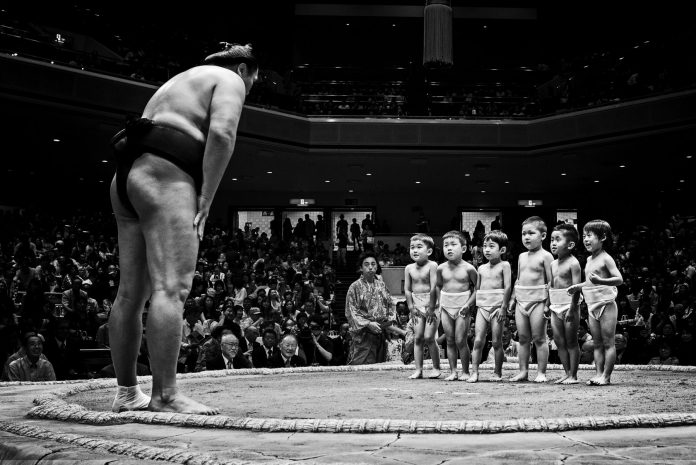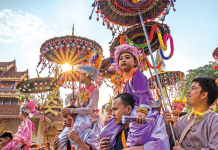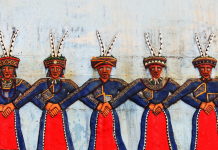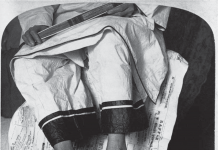
With a history spanning over 2,000 years, sumo offers an exhilarating taste of Japanese culture
Text Sophie Ibbotson
Photos Lord K2
Shinto origins
Shinto is ‘the way of the gods’ and, just as it is for many mortals, sumo wrestling is a favourite pasttime. For nearly 2,000 years, sumo wrestlers have performed their martial art, first in intimate shrines, and then in stadiums before thousands of spectators. At least as early as the 3rd century AD, the wrestlers would perform complex rituals to purify both their body and their spirit, and then fight for the entertainment of the gods during the matsuri (religious festivals). It was a sacred act of ritual, not a sport.
But what begins in the temple often spreads to the court. The rulers of Japan felt that they, too, should be able to enjoy the spectacle: it was surely wasted on the Shinto gods. Legend has it that the Emperor Yuryaku (418-79) ordered two naked women to sumo wrestle before a particularly arrogant carpenter who claimed to have never made a mistake. Distracted by the women (though whether it was by their wrestling skills or their physiques, we shall never know), the carpenter blundered in what he was doing, and was summarily executed by the Emperor.
For the most part, though, sumo was something to be enjoyed by all involved – competitors and spectators. From the Nara period (710-794) onwards, wrestlers would be invited from across Japan to pit their skills against one another in competitions hosted at the imperial court. The tournaments normally coincided with important festivals, and were accompanied by banqueting, music, and dancing. The sumo wrestlers were expected to join in with these lively activities, too.
The sumo these earlier wrestlers practiced would be almost unrecognisable to their modern counterparts. There were few rules, wrestlers frequently drew blood, and you could box your opponent as well as wrestle him to the ground. In fact, not all the wrestlers were men: one particularly celebrated sumo wrestler was a nun! With topless women pitted against blind men, and prostitutes and warriors fighting one another to settle the political scores of their patrons, the sumo ring was not dissimilar to a gladiator arena.

Sumo goes professional
Sumo wrestling developed into a serious, professional event from the 14th century onwards, becoming particularly refined during the Edo period (1603-1867). The popularity of sumo expanded from the imperial court, and newly wealthy merchants patronised tournaments. The best wrestlers from each province would be ordered to attend national competitions, and many of them were samurai who found it a fitting way to supplement their income.
The first professional sumo tournament took place at the Tomioka Hachiman Shrine in Tokyo in 1684, and it is therefore regarded as the birthplace of sumo as a professional sport. The shrine was protected and patronised by the Tokugawa shogunate, and hence both the shrine – and sumo – was seen to be endorsed by the shogun. Two basho, or tournaments, took place here each year, one in the spring and the other in the autumn, and the systems and rules of sumo became increasingly sophisticated.
The banzuke – the ranking of sumo wrestlers – dates from this period: the earliest surviving banzuke list dates back to 1761. Two weeks before a tournament, sumo judges assign ranks to each of the 600 wrestlers, based on how they performed in the previous competition. The wrestlers’ shikona (ring names), home town, and rank are listed, with those who are ranked highest appearing at the top of the list, and in the biggest writing. Even today, the banzuke is written out by hand in elegant calligraphy, and takes about a week to complete. Printed copies, on smaller sheets, can then be made and distributed to sponsors and spectators.
When the first foreigners were allowed to enter Japan in the 19th century, shows of sumo wrestling were sometimes presented to entertain them. The American Commodore James Perry arrived in Japan in 1853, and described the wrestlers he saw as “overfed monsters”. The Japanese were similarly unimpressed by a boxing demonstration by American sailors: they decided they were far too scrawny. The foreigners bought woodcut prints of sumo wrestlers and geisha girls as souvenirs, and wrote about what they saw, contributing significantly to foreign stereotypes of the Japanese, many of which are still held today.

As the sport of sumo grew in popularity and complexity, it demanded a professional organisation to oversee it. Each region had its own association for organising tournaments, and in 1925 the two largest of these – the Tokyo Association and the Osaka Association – merged to create the Japan Sumo Association. There was a strong tie between the association and the Japanese military: the first chairman was a lieutenant general, and his successor was an admiral in the imperial navy. It was only after WWII that this link with the military was severed, and the association became attached to the Japanese Ministry of Education.

Modern sumo
Though not quite the sport of the masses in Japan (soccer has sneaked past it in popularity in recent years), sumo wrestling remains incredibly popular. Major tournaments are screened on television, there’s stiff competition for the best ringside seats, and the highest ranked sumo wrestlers have become well-paid celebrities, beloved by their fans.
For a taste of Japanese culture, visitors should attend a sumo tournament. Each tournament runs for 15 days. Although they take place in vast stadiums, at weekends and on national holidays the tickets frequently sell out. To be sure of getting good seats, you’ll need to pre-book your tickets through the official vendor, or online at www.buysumotickets.com. The most prestigious tournaments take place in Tokyo, Osaka, Kyoto, and Hiroshima, and you can opt for a traditional box seat (where you’ll sit on cushions), or for a western-style seat on the balcony.
Matches begin at 8.30 in the morning, with the lower-ranked wrestlers competing first. The ranking of the wrestlers, and the number of celebrity wrestlers, increases throughout the day, and the atmosphere in the stadium also livens up as more and more spectators arrive to watch. The ring entering ceremonies, which take place between each division, are just as interesting as the bouts of sumo themselves. As the stakes are high – prize money can reach in excess of USD 95,000 for the winner of the highest division, and judges award special cash prizes, too – you’ll feel the tension mounting as the tournament progresses.
Many of the wrestlers competing are not actually Japanese. Foreigners have been permitted to compete in sumo tournaments since the 1960s, and the Mongolians, in particular, give the locals a run for their money: 56 of the 58 tournaments held between 2006 and 2016 were won by Mongolian wrestlers. Three Mongolians, Hakuhō Shō, Harumafuji Kōhei, and Kakuryū Rikisaburō – to give them their sumo shikona – are currently active in tournaments and have reached the highest possible rank of yokozuna.
The sumo wrestler may be a social stereotype typically associated with Japan, but the traditions of sumo are deeply embedded in Japanese culture, and celebrated and enjoyed by Japanese fans. Experiencing a tournament will undoubtedly be one of the highlights of your visit to the country, so be sure to add it to your bucket list.
For more stories and photos, check out Asian Geographic Issue 121.



![The Road to Independence: Malaya’s Battle Against Communism [1948-1960]](https://asiangeo.com/wp-content/uploads/2021/07/WhatsApp-Image-2021-07-26-at-11.07.56-AM-218x150.jpeg)






